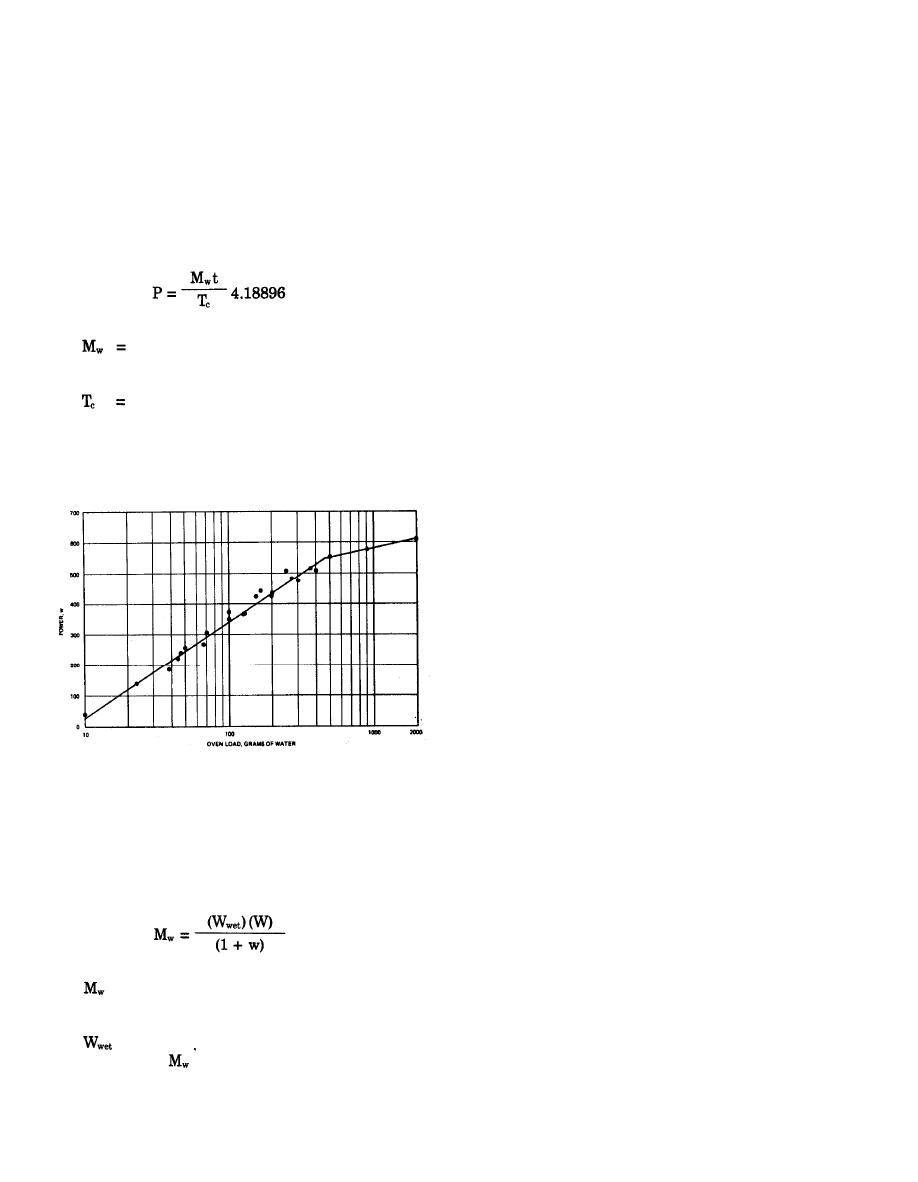
TM 5-818-4/AFM 88-5, Chap. 5
cannot be made, experience has shown that close. vis-
equation (B-3) and finding a comparable value of pow-
ual observation often can be used to determine if soil
er from a plot similar to figure B-8 for the particular
overheating is occurring. An alternative approach is to
oven used, the drying time may be calculated from
incrementally dry a duplicate specimen until a con-
equation (B-1).
stant weight is obtained, calculate the water content,
(5) It may not be possible to successfully dry cer-
and input this value into equation (B-1).
tain soils in the microwave oven. Gypsum may decom-
(3) The useful power output "P" is determined in
pose and dehydrate under microwave excitation. High-
the laboratory by subjecting a mass of distilled water
ly metallic soils (iron ore, aluminum rich soils, and
to microwaves for a given time and then measuring
bauxite) have a high affinity for microwave energy and
the rise in temperature induced in the water. Power in
overheat rapidly after all the free water has been va-
watts is calculated from
porized. Hence, extreme care is required when drying
these soils. For the same reason, metallic tare cans or
aluminum plates are not permissible as specimen con-
(B-2)
tainers.
where
(6) Because microwaves are a type of radiation,
normal safety precautions to avoid undue exposure
mass of distilled water in the oven, grams
=
should be observed.
t
increase in temperature of the distilled
water, degree Centigrade
b. Proctor penetrometer. The Proctor penetration
time in the oven for calibration, seconds
resistance method in the hands of inspection personnel
A plot is then made of power output and oven load
experienced in its use provides a rapid expedient check
(mass of water in oven) in grams of water as shown in
on whether the field water content is adequate for
figure B-8.
proper compaction. However, the method is suitable
only for fine-grained soils because coarse sand or grav-
el may cause erroneously high resistance readings. The
method consists of compacting by the procedure used
for control of a representative sample of soil taken
from the loose lift being placed. The compacted speci-
men is weighed, and the wet unit weight is deter-
mined. The penetration resistance of the compacted
specimen in the mold is then measured with the soil
penetrometer. The moisture content can then be esti-
mated by comparing the penetration resistance of field
compacted specimens with a relation previously estab-
lished in the laboratory between wet unit weight,
penetration resistance, and moisture content. The pro-
cedure requires about 10 minutes and is sufficiently
accurate for most field purposes. The procedure to de-
termine the relation between wet unit weight, penetra-
tion resistance, and moisture content is described in
ASTM D 1558. The relation is generally developed in
Figure B-8. Power Applied by the Oven to Dry Moist Soils.
conjunction with the compaction test.
c. Other methods. Other methods for determining
water content include drying by hot plate or open
flame, drying by forced hot air and a rapid moisture
(4) The water content estimate is used to calculate
test that uses calcium carbonate. In the hot plate
the mass of water in the specimen from
method, a small tin pan and a hot plate, oil burner, or
gas burner (something to furnish fast heat) are used. A
sample of wet soil is weighed, dried by one of the above
(B-3)
mentioned methods, and weighed again to determine
where
how much water was in the sample. This method is
= mass of the water in the specimen, and
fast, but care must be taken to ensure that the materi-
equivalent to oven load in figure B-8,
al is thoroughly dry. Also, if both organic matter and
grams
bound water are removed, higher water content deter-
= wet weight of the specimen, grams
minations than those obtained by ovendrying some-
By calculating
(oven load in fig. B-8) from
times result. In the forced hot air, a sample is placed in
B-12



 Previous Page
Previous Page
